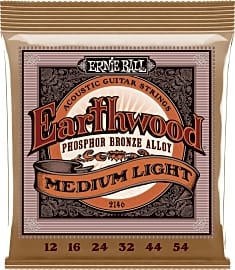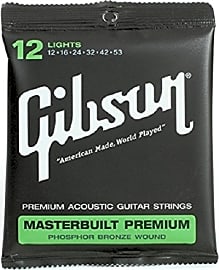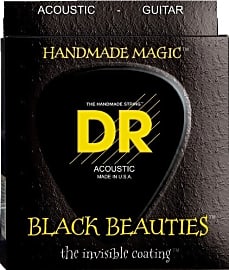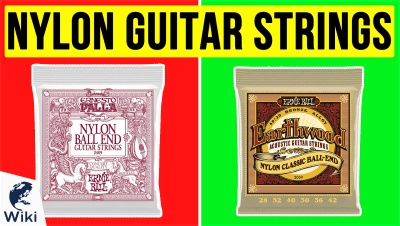The 10 Best Acoustic Guitar Strings

This wiki has been updated 34 times since it was first published in October of 2016. No matter how good your acoustic guitar is, you'll need to replace its strings from time to time. Whether you're rehearsing for an unplugged television appearance, leading singalongs around a campfire, or working up the nerve to sign up for your first open mic, this list ranks a range of trusted options, so you'll be able to find a set that works for you and your instrument. When users buy our independently chosen editorial recommendations, we may earn commissions to help fund the Wiki.
Editor's Notes
February 25, 2020:
Although most will find that selecting acoustic guitar strings comes down to subjectivity, we've kept a wide range of popular favorites that many players, from professional to casual, reach for again and again. With that said, we've opted to remove the Vibe Phosphors, as they simply don't hold their tuning as well as some. But for top options, it remains hard to beat D'Addario Light, Elixir 80/20, and Ernie Ball Earthwood. The Ernie Balls do sound a bit tinny to some, but they're quite affordable and offered in a range of weights. We've opted to add Martin MEC12 Clapton's Choice, too. A phosphor bronze option, they tune up easily, even if they do tend to feel a bit stiff. For an alternative from Martin, consider Martin Authentic Lifespan 2.0. As their name suggests, they're designed for longevity, which is a good thing considering that they're a bit more expensive than many.
Finally, we selected one fun option, DR Strings Hi-Def Neon. No, they probably won't give you the warmest, richest sound, but they can be fun and perhaps even educational when strung on guitars for beginners.
Special Honors
Martin Titanium Core They're pricier than nearly any other option, but Martin Titanium Core live up to their name by offering a flexible titanium core that's wrapped with pure nickel. Not only does this construction allow them to provide excellent tuning stability, it also makes them more resistant to corrosion than many choices. martinguitar.com
If You Like It, Then You’ve Gotta Put A String On It
For example, one way they differ from classical guitar strings lies in the materials.
If you’re looking at acoustic guitar strings, you probably already know a few of the basics. For example, one way they differ from classical guitar strings lies in the materials. Acoustic strings are normally made from some type of metal, whereas classical strings are often made from nylon (or catgut). You may know, too, that acoustic strings come in different sizes, affect the way the guitar sounds, and are produced by many manufacturers, such as Martin and D’Addario. But there is much, much more to know about this crucial guitar component.
For instance, when it comes to materials, you’ll most commonly hear about bronze strings, either 80/20 bronze or phosphor bronze. In actual fact, these aren’t exactly made of bronze. The former contains 80 percent copper and 20 percent zinc, while the latter contains similar materials wrapped with a phosphorous wire. Where you’ll really notice this difference in composition is in the sound. A set of 80/20 strings tends to be brighter, more ringing, whereas a set of phosphor bronze will give you a warmer, darker sound.
Another favorite of both novice and experienced players is the silk and steel variety. These have a steel core wrapped with nylon, silk, or some other material that’s softer than a metal. This makes the strings both a little easier on the fingers and a bit more mellow sounding. Many folk guitarists and fingerstyle players opt for these.
No matter the string material, gauge is extremely important. Gauge refers to the thickness of the string and is an exact measurement given in inches. Since guitar strings are thin, these numbers are tiny; a really thin E string might be 0.011 inches. Most people have a hard time picturing a size this small and understanding the difference between gauges at this size, so manufacturers use a classification system along with the exact numbers. This system ranges from extra light to heavy.
Making Sense Of The Options
Knowing the basics about types of strings (e.g., bronze vs. nylon, light vs. heavy) is a great start to choosing strings, but you might notice that there are a few other factors to consider. Manufacturers have many ways of improving string sound, quality, and life, including different winding methods, cores, coatings, and manufacturing processes. You’ll probably even notice that string makers come out with new strings relatively regularly, offering new-and-improved this and longer-lasting that. So, unless you’re a professional musician, how on earth can you be expected to choose?
This may seem like the most unhelpful advice ever given, but before you grab a pitchfork, consider the ultimate subjectivity of playing the guitar.
The answer is much simpler than you’d suppose, and it’s this: You’re going to have to try a range of different strings. This may seem like the most unhelpful advice ever given, but before you grab a pitchfork, consider the ultimate subjectivity of playing the guitar. Yes, there are foundational musical principles and good practices, but how a guitar feels and sounds is going to be different for every player. That’s just one part of the reason why the world gets to enjoy both Jimi Hendrix and Sungha Jung. The truth is, if you like a set of strings, the way they feel and sound, then that makes them right for you.
That said, brand-new guitar players might keep a few simple ideas in mind as they make their selections. Lighter strings are perhaps better at first, because they’ll let you build up your strength and calluses comfortably, as are coated strings for the sake of durability. The size and type of the guitar is important, too. You don’t want to put light nylon strings on a guitar made for steel strings, just as you shouldn’t put heavy steel strings on a classical guitar. Ignoring the type of strings the guitar requires could lead to instrument damage.
You should also know that strings will wear out, they will snap, and you’re going to have to replace them. Don’t be hesitant to try something new. There’s a vast difference between reading about sets of strings and playing them, so you probably won’t find your new favorites through research alone. And should you happen not to like the new ones, they’ll need to be replaced at some point — so you aren’t stuck with them forever.
A Change Would Do You Good
One common question guitar players have is: When do I need to change my strings? Unfortunately, there isn’t a truly definitive answer to this, either, such as “after every 100 hours” or “every three weeks.” There are some signs to keep an eye out for, however, that will let you know it’s probably time for a change.
You’ll probably want to get a string winder to make the process easier and faster.
If, for instance, you notice that the old strings look dull or discolored, appear to have some rust, or are unraveling, then a new set of acoustic strings may be overdue. Rely on your ears, too, and not just your eyes. If the guitar won’t stay in tune or it’s lost a lot of its brightness, you might need to put a new set of strings on. Where you live and how much you play are important factors to consider, as well. You’ll need new strings more often if you live in a humid climate, expose the guitar to a lot of smoke, have sweaty hands, or play often.
One way you can extend the life of your strings is by taking good care of them. Before you play, wash your hands, and when you finish, wipe the strings with a clean cloth. Take the time to wind them properly, too; don’t do a quick or careless job. You’ll probably want to get a string winder to make the process easier and faster. And, finally, always keep an extra set of strings handy so that a broken string doesn’t ruin your jam session.















